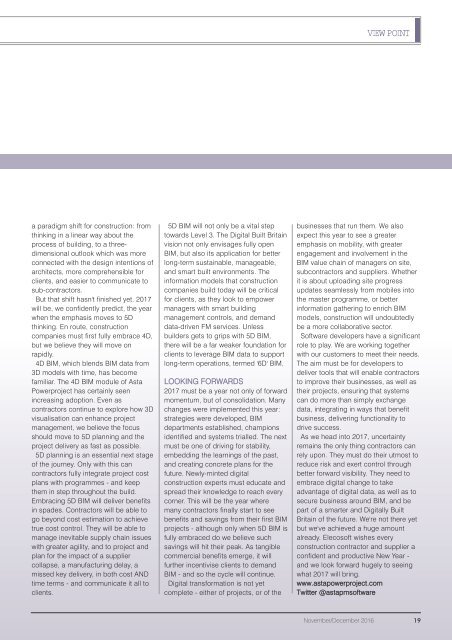You also want an ePaper? Increase the reach of your titles
YUMPU automatically turns print PDFs into web optimized ePapers that Google loves.
VIEWPOINT<br />
a paradigm shift for construction: from<br />
thinking in a linear way about the<br />
process of building, to a threedimensional<br />
outlook which was more<br />
connected with the design intentions of<br />
architects, more comprehensible for<br />
clients, and easier to communicate to<br />
sub-contractors.<br />
But that shift hasn't finished yet. 2017<br />
will be, we confidently predict, the year<br />
when the emphasis moves to 5D<br />
thinking. En route, construction<br />
companies must first fully embrace 4D,<br />
but we believe they will move on<br />
rapidly.<br />
4D BIM, which blends BIM data from<br />
3D models with time, has become<br />
familiar. The 4D BIM module of Asta<br />
Powerproject has certainly seen<br />
increasing adoption. Even as<br />
contractors continue to explore how 3D<br />
visualisation can enhance project<br />
management, we believe the focus<br />
should move to 5D planning and the<br />
project delivery as fast as possible.<br />
5D planning is an essential next stage<br />
of the journey. Only with this can<br />
contractors fully integrate project cost<br />
plans with programmes - and keep<br />
them in step throughout the build.<br />
Embracing 5D BIM will deliver benefits<br />
in spades. Contractors will be able to<br />
go beyond cost estimation to achieve<br />
true cost control. They will be able to<br />
manage inevitable supply chain issues<br />
with greater agility, and to project and<br />
plan for the impact of a supplier<br />
collapse, a manufacturing delay, a<br />
missed key delivery, in both cost AND<br />
time terms - and communicate it all to<br />
clients.<br />
5D BIM will not only be a vital step<br />
towards Level 3. The Digital Built Britain<br />
vision not only envisages fully open<br />
BIM, but also its application for better<br />
long-term sustainable, manageable,<br />
and smart built environments. The<br />
information models that construction<br />
companies build today will be critical<br />
for clients, as they look to empower<br />
managers with smart building<br />
management controls, and demand<br />
data-driven FM services. Unless<br />
builders gets to grips with 5D BIM,<br />
there will be a far weaker foundation for<br />
clients to leverage BIM data to support<br />
long-term operations, termed '6D' BIM.<br />
LOOKING FORWARDS<br />
2017 must be a year not only of forward<br />
momentum, but of consolidation. Many<br />
changes were implemented this year:<br />
strategies were developed, BIM<br />
departments established, champions<br />
identified and systems trialled. The next<br />
must be one of driving for stability,<br />
embedding the learnings of the past,<br />
and creating concrete plans for the<br />
future. Newly-minted digital<br />
construction experts must educate and<br />
spread their knowledge to reach every<br />
corner. This will be the year where<br />
many contractors finally start to see<br />
benefits and savings from their first BIM<br />
projects - although only when 5D BIM is<br />
fully embraced do we believe such<br />
savings will hit their peak. As tangible<br />
commercial benefits emerge, it will<br />
further incentivise clients to demand<br />
BIM - and so the cycle will continue.<br />
Digital transformation is not yet<br />
complete - either of projects, or of the<br />
businesses that run them. We also<br />
expect this year to see a greater<br />
emphasis on mobility, with greater<br />
engagement and involvement in the<br />
BIM value chain of managers on site,<br />
subcontractors and suppliers. Whether<br />
it is about uploading site progress<br />
updates seamlessly from mobiles into<br />
the master programme, or better<br />
information gathering to enrich BIM<br />
models, construction will undoubtedly<br />
be a more collaborative sector.<br />
Software developers have a significant<br />
role to play. We are working together<br />
with our customers to meet their needs.<br />
The aim must be for developers to<br />
deliver tools that will enable contractors<br />
to improve their businesses, as well as<br />
their projects, ensuring that systems<br />
can do more than simply exchange<br />
data, integrating in ways that benefit<br />
business, delivering functionality to<br />
drive success.<br />
As we head into 2017, uncertainty<br />
remains the only thing contractors can<br />
rely upon. They must do their utmost to<br />
reduce risk and exert control through<br />
better forward visibility. They need to<br />
embrace digital change to take<br />
advantage of digital data, as well as to<br />
secure business around BIM, and be<br />
part of a smarter and Digitally Built<br />
Britain of the future. We're not there yet<br />
but we've achieved a huge amount<br />
already. Elecosoft wishes every<br />
construction contractor and supplier a<br />
confident and productive New Year -<br />
and we look forward hugely to seeing<br />
what 2017 will bring.<br />
www.astapowerproject.com<br />
Twitter @astapmsoftware<br />
November/December 2016 19

















